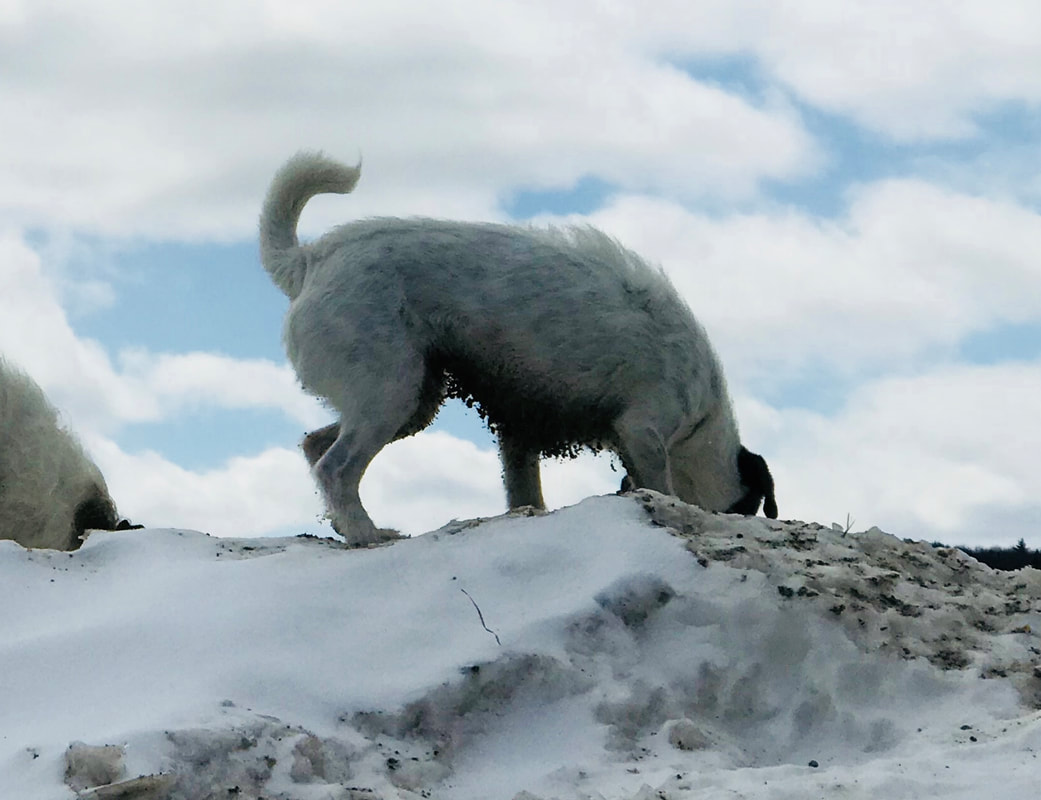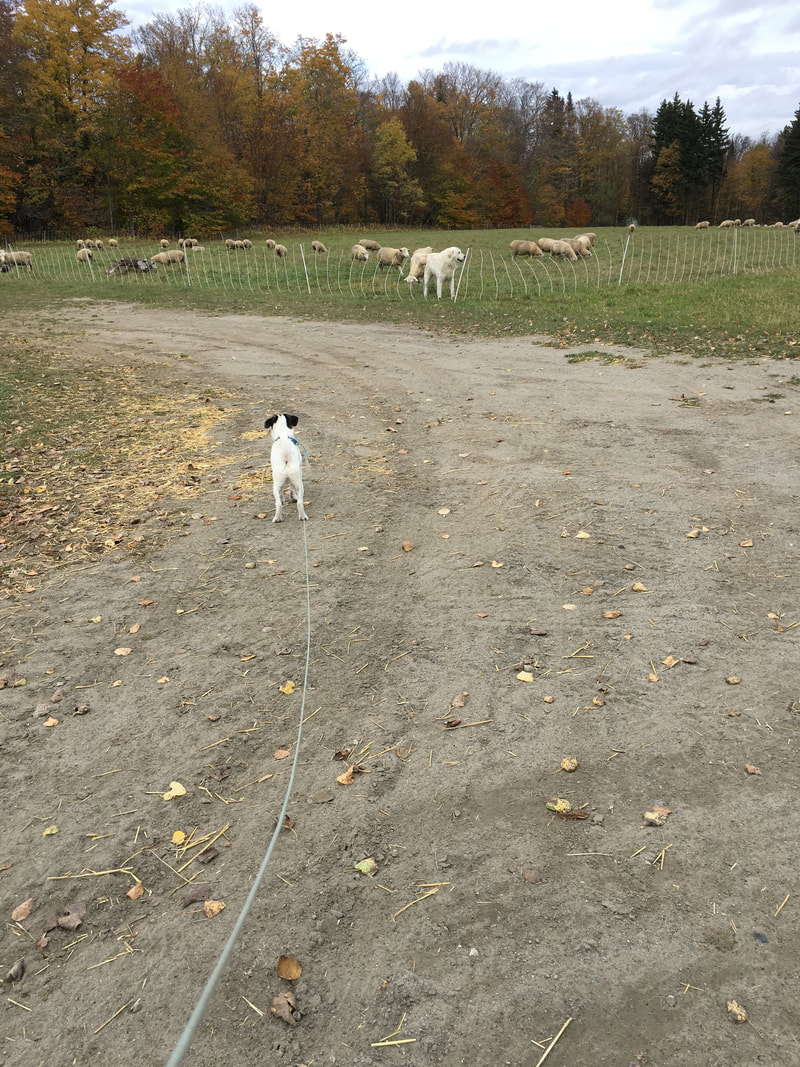|
I have recently realized that my understanding of training rules has done a 180 degree turn over the years. I realized this because I am still using the same phrases, and people I teach are interpreting them the way I used to, rather than what I mean now. Confusing. We frequently use the word "allow" to describe rules, as in "my dog is not allowed on the furniture". Or I might say to a client, "you must no longer allow him to ignore your recalls". This is why my dogs are not allowed to jump on the furniture or into the car unless they are invited! When I looked up the definition of "allow", I read:
If I'm withholding permission, that means I need to have trained him to stay on the floor until I give that permission. That doesn't happen by yelling at him after he's already gotten up there. It happens via the second part of the definition. If I'm not giving him time or opportunity, that means I need to have set up the environment in a way to prevent him from having access to the couch. I use an ex pen...around the couch! Growing up (for a puppy) or settling in to a new home (for a rescue) with habits of sleeping on comfortable dog beds on the floor (in a sun spot or shady spot depending on the temperature) makes it much easier to prevent that couch jumping habit later. During that time you can also teach a calm and reinforcing "off" cue in case the mistake is made (you can see more detail on this in my previous post). When Wilder first moved in with us, he was not "allowed" to chase sheep As to that rule for my clients about not allowing their dogs to ignore recalls, I provide all new clients with a long rope and encourage them to use the same rule I use with new dogs in our family. Note, the rule is FOR ME. That rule is that the puppy or dog is always on a rope when outside until two requirements are met, those being that the puppy turns one year old and has a rock solid recall. In this way, I do not allow the dog to run away. If she is attached to me via a rope, then she is prevented from making that mistake. I keep the rope short enough at first that it's easy to do lots of little recalls with great treats. When the puppy/dog is responding quickly, I can let the rope out a little at a time over many days, weeks and months until that recall is rock solid at great distances and even under great distractions. In this way, I have not allowed the dog to ignore me. Unfortunately, too often what happens is that in fact the people allow the dog to make a mistake and then punish when it does. That is just unfair. Let's look at one of the definitions of "rule":
1 Comment
Saying "no" with positive reinforcement sounds like an oxymoron. I find there are two main instances when people reach for that "no!". One situation is when they want to respond if an animal does something "wrong". The other situation (I find is even more of an issue with horse people), is how to convey that the animal must never do a particular behavior. Examples: "what do I do when my dog steals food off the counter?" "I need to teach my horse never to go over the top of me" In this post, I will address the the first situation, in which people think they can't let the animal get away with something. They are often upset or angry at what has happened- something has been chewed up or eaten or peed on. They want to DO something in response. In a post on my Bookends Farm blog, I address the second situation. The first thing to examine is that "no" is not an action. It doesn't give any information. If, as you were reading this, I walked up to you and said "no!"...what would your reaction be? Take a minute to think about this. think, think, think. OK, got your response? If it happened to me, I would think, "no what?" Am I doing something wrong? If "no!" has been previously paired with punishment, I would also be fearful. I would certainly stop reading on the computer, if just to look at the naysayer. Depending on past punishment, I might back away or even run away. That might or might not stop what you didn't like, but it wouldn't help me understand what it was that you were saying "no" to. Was it the reading? Was it specifically what I was reading? Was it touching the computer (are my hands dirty)? Was it sitting? Was it sitting in a particular chair? Was it the room I was in? Was it something else I was doing (biting my nails, chewing my lip, wiggling a foot, crossing my legs, the glass I had put water in?)? So you've just said "no", and there is a good possibility that I've stopped doing what you didn't like because I froze when you said it...but I have learned nothing. There is also a good possibility that I've become more fearful of you, your presence, or your proximity and will stay further away from YOU in the near future (after all, everything was fine until you walked in the room). Remember, punishment has unintended consequences. You may think that because you stopped me, I won't do it again, but since I have no idea what your concern was, I may or may not do it again. If this seems farfetched, try this scenario: a dog is half asleep and chewing an itch when a person walks in and says "no!". What is the person saying "no" to? Is it sleeping? Chewing? Where the dog is (on the couch, on the owner's favorite sweater, in a specific room), the timing? (dog just came in and is wet or muddy)...etc! Instead of saying "no", I give my animals something To Do instead. I give them a solution to my problem (remember, it's not a problem for them or they wouldn't be doing it). To use the couch example, my dogs are not allowed on couches unless they are invited onto the couch with someone. I chose this parameter because it means I can assess when and in what conditions they are allowed on the couch. If they are muddy, I don't invite them on! If they are a bit damp, I can cover the couch first. In this very short clip, we have all been out in a misty rain so that my pants are as damp as the dogs. I spread an afghan out on the couch before I sit down, and then pat my legs twice which is the invitation to have the dogs jump up and join me. I have a clear method for encouraging dogs to stay on the floor, which I won't go into here, but then the question is, what do I do if they get on the couch without me? After all, if they spend time on the couch with me, they will discover it's a lovely place to nap and will understandably want to do it at other times. I have to decide what it is that I want them TO DO when I find them on the couch. Well, I want them to get off the couch. So I need to train that. Before I need it. So the dogs clearly understand what I mean. I train "off" to mean, "jump down off whatever you are on". Often I train this in the barn, using a hay bale. If you don't ever want your dog on the couch, you don't want to use the couch as a training tool because you'll be encouraging them up there where you don't ever want to see them. Even if I allow them up sometimes, I prefer to train the "off" elsewhere. In this video, Eloise demonstrates that she clearly understands the "off" behavior. You can train this with a hand target or with just tossing treats. In this final video, Wilder is learning to jump off the Klimb platform which he has been heavily reinforced for being on recently. I give the cue and immediately toss a treat. Before turning the camera on, the first couple times he actually ignored the tossed treat. I encouraged him off so he could get it and then was happy to jump off the next time. By preceding the toss with the cue "off", he will start to figure out that when I say "off!", a treat will be tossed. In the last couple reps you can see him start to look for the toss when I say "off!" even before I move. That's the first step. If you have experience with chained behaviors, you may be asking why my dogs don't jump onto the couch just to be told "off!" and get a treat. The answer is that once I have a solid "off" behavior trained elsewhere (my dogs always respond immediately to the cue), then they don't get a treat for jumping off the couch. We practice on hay bales and the Klimb platform and stone walls and tree stumps. They get treats for jumping off them so that the response is immediately and automatic. When they hear it from the couch, they respond the same way. But they don't get a treat. If I put it into words, their thinking could be:
every time I get on the couch, she tells me to get off before I can even get comfortable and I don't get anything for it. I might as well just stay on the floor. Remember, training is a process. I would not give the dog access to the couch (using ex-pens, baby gates, crates or other management tools) until I have a clear set of behaviors to deal with it. They need to get heavy reinforcement for staying on the floor and know the "off" cue for any time they make a mistake. To get back to "no", I don't use the word. Instead, I am proactive about training skills that will get me out of problem situations and I train those with positive reinforcement. |
what's this?Occasionally, I have thoughts I want to share. This may be inspired by a success, a struggle, or a conversation. Thanks for reading! Archives
August 2021
Categories |
Photos from miguel.discart, shixart1985 (CC BY 2.0), Günter Hentschel, skua47, Günter Hentschel, shixart1985



 RSS Feed
RSS Feed